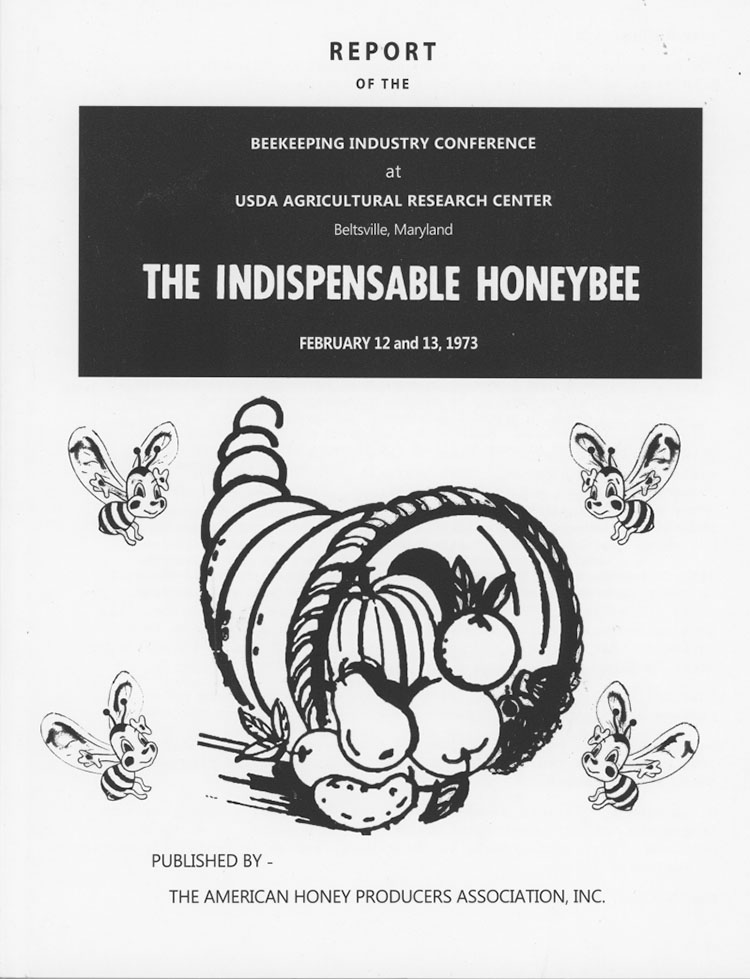by G. Splevin
In the Nov. 2015 and January 2016 Bee Culture magazine I wrote of the 1973 report, “The Indispensable Honey Bee.” The USDA and University researchers contributed much at this national conference. Reviewing the report from 43 years ago, the similarities today are as if the past has changed nothing for beekeeping or our honey bees. “Beyond producing honey and other products, probably the chief value of bees lies in their ability to pollinate over 60 agricultural crops and thus increase the production of fruit and seed. Bees are responsible for 80 to 85 percent of all crop pollination performed by insects in this country.”(1) stated Dr. N.P. Ralston, Assoc. Director Science and Education with the U.S. Dept. of Agriculture. Dr. Ralston acknowledged the Honey Bee Research Lab in Arizona as featuring scientists involved in “basic and applied research” of the “pollination requirements of a number of crops, factors affecting pollinating activities, the effects of pesticides, and the nutrition, biochemistry, physiology, and behavior of honey bees.”(2) He spoke to the attendees at this honey bee conference about research at other USDA labs or universities working to control and for the prevention of bee diseases, management of bees for pollination and honey production, “biology and management of non-Apis species of bees for pollination,”(3) bee breeding and genetics, control of Nosema, controlled bee mating and stock maintenance, the development of a genetic strain of bees with a “special affinity for collecting alfalfa pollen,”(4) new methods for storing honey bee semen and queens, and using “heat and cold rather than chemicals to control the wax moth, one of the beekeepers’ worst problems.”(5)

Reading this 1973 report and listening to beekeepers today, and reading the beekeeping literature today, what happened to these “research advances?” Dr. Ralston’s report reminds me then and now honey bees are still trying to be treated as “feedlot livestock.” In the 1973 report USDA spoke of “excellent progress in developing artificial diets and mass feeding, or feedlot beekeeping.”(6) Research today is concluding honey bees are healthier when they eat a natural diet comprised of a variety of floral sources, untainted by pesticides. The comparisons to 1973 and today in the bee industry and within the management of honey bees continue with Dr. Ralston’s statement, “Pesticides comprise the largest single problem in the industry. Pesticides are a concern not only of those involved in beekeeping, but also those of us involved in the broad agricultural picture.”
Dr. Ralston comments that “500,000 colonies are killed or seriously damaged by pesticides annually in the U.S.”(7) Beekeeper friends utilized the indemnity program at that time, but like today it did not “ease the burden” of lost colonies. I encourage you to review this report for yourself, the moment in time depicted in this report is as if time was actually frozen, and by reading this I am unthawing the pages, because the facts on the ground, the world of beekeeping has not changed much.
Varroa destructor has certainly kicked the wax moth from its pedestal as “beekeepers’ worst problem.” However, in 1973 monoculture “decreases crop diversity, . . . The shift toward increasing air applications of pesticides . . . toward materials more hazardous to bees . . . and toward newer materials with shorter residual action requiring more frequent application . . .”(8) are the same issues today.
Dr. Ralston’s report also spoke of carbaryl’s use on corn creating contaminated pollen which bees took back to the hive and the nurse bees and brood were killed. This 1973 scenario is a mirror of the issues surrounding neonicotinoids used on corn today (although there are additional concerns with this systemic pesticide in its half-life, and dust-off toxicities). In 1973 the USDA acknowledged bees visited corn and collected pollen; a fact forgotten in the recent past by the USDA. I am saddened to again read that in 1973 the USDA was still unsure of Integrated Pest Management. “One especially interesting development calls for managing the use of pesticides by applying them only when enough pests are present to threaten crops.”(9)
As a former apple grower, I am saddened by this revelation by the USDA in 1973; and frustrated today that they refuse to learn from their own history. Dr. Ralston cites a research project in 1968 on cotton in Arizona. Cotton growers spent $198,000 on pest control. Pesticide applications were “admittedly heavy and prolonged, and damage to the honey bee industry was extensive.”(10) In 1969 the County Extension Service was asked to help cotton growers “develop a better insect control program.” “Scouts were hired and trained. By the end of the season, as a result of using the scouts, spraying costs had dropped to an amazingly low $36,000, over half of which went to pay for the scouts. But, of particular importance to area beekeepers, colonies were restored to almost their original numbers.”(11)
Dr. Ralston believed this method of pest management would “gain in importance.” What has happened to scouts in the field assessing pest levels? What has happened to Integrated Pest Management?
Dr. Ralston’s conclusion shined hope in 1973 on the health concerns for honey bees, but it is a statement which could have come straight from the President’s National Strategy Promoting the Health of the Honey bee and other Pollinators:
“Constant educational pressure to motivate concern for bees provides another means of minimizing the pesticide problem for beekeepers. Growers must be reminded of the need for using less hazardous materials, using them only when essential, reducing air application in favor of ground spraying, and timing applications to avoid bee flight . . . with understanding and good will on all sides, backed by a program of research and education by State and Federal agencies, we can strive for practical solutions to the problems that beset the beekeeping industry.”(12)

Dr. Ralston’s comments were written in 1973, 43 years ago! If I looked at Federal research of 1930 would I find the same platitudes towards honey bees? Probably not, but the effects of the dust bowl were greatly changing agricultural practices. However, many of those hard-learned lessons of the 1930s are being repeated today.
Other researchers of the USDA offer similar commentary in 1973, as beekeepers and the public hear today:
The economics of beekeeping and pollination services needed examining in 1973, as it does today. The culture of beekeeping still is wrought with territorial attitudes, undercutting of rates, etc. today as it was in 1973. S.E. McGregor concludes his comments to the 1973 group expressing the need for bee specialists and plant specialists on eleven pollinated crops, as well as support for Extension pollination specialists to “advise both the grower and the beekeeper.”(15)
Having lived through 1973 with my own bees, and reading this document of a point in time of the bee industry, has me remembering, thinking, and challenging my fellow beekeepers in my own local and state association. I challenge my daughters who keep bees to stop this repetition of history, and truly work to help “the indispensable honey bee.” With the magazine editor’s indulgence I hope to continue this analysis of 1973, and spark discussion among my fellow beekeepers about our past and our present; and do we want them to continue to be the same. Stay tuned for further discussion on beekeeping in 1973 and 2015 from this “curious guy.”
1. “The Indispensable Honey Bee,” published by The American Honey Producers Association, Inc, 1973; page 9, (re-print available from Bee Culture)
2. Ibid., page 10
3. Ibid.
4. Ibid.
5. Ibid, page 11
6. Ibid, page 12
7. Ibid, page 11
8. Ibid, page 12
9. Ibid, page 14
10. Ibid
11. Ibid
12. Ibid, page 16
13. “In ‘Just Eat It,’ Filmmakers Feast For 6 Months On Discarded Food,” National Public Radio, All Things Considered, Updated November 19, 2015 2:45 PM ET, http://www.npr.org/sections/thesalt/2015/11/18/456489490/in-just-eat-it-filmmakers-feast-for-6-months-on-discarded-food
14. “The Indispensable Honey Bee,” page 22
15. Ibid, page 27






